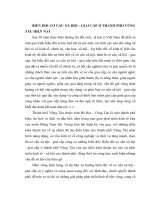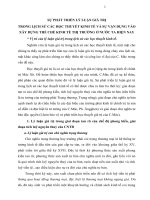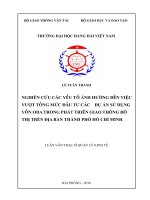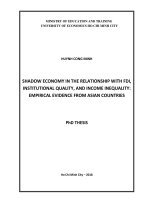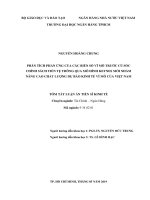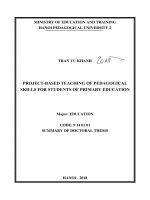Các nhân tố ảnh hưởng đến chất lượng nguồn nhân lực trong lĩnh vực du lịch tỉnh bà rịa vũng tàu tt tiếng anh
Bạn đang xem bản rút gọn của tài liệu. Xem và tải ngay bản đầy đủ của tài liệu tại đây (506.33 KB, 26 trang )
MINISTRY OF EDUCATION AND TRAINING
LAC HONG UNIVERSITY
PHAM CAO TO
FACTORS AFFECTING THE QUALITY
OF HUMAN RESOURCES IN THE TOURISM
OF BA RIA - VUNG TAU PROVINCE
THESIS SUMMARY
OF DOCTOR OF PHILOSOPHY ON BUSINESS ADMINISTRATION
Dong Nai, 2020
PUBLISHED RESEARCH WORKS OF THE AUTHOR
1. Pham Cao To (2017), "Factors affecting the quality of human resources among
tourism enterprises in Vung Tau City", Asia-Pacific Economic Review, No. 506
November / 2017, p. 62-64.
2. Pham Cao To (2018), "Improving the quality of training human resources for
tourism in Ba Ria – Vung Tau province ", Asia-Pacific Economic Review, No. 513,
March 2018, p. 90-92.
1
CHAPTER 1
OVERVIEW OF THE RESEARCH THEME
- Subjects of the survey are tourism enterprises, agencies and organizations where
information is provided by managers. They are directors, deputy directors or heads of
human resources. The survey participants are experts with long-term working
experience and a lot of experience in tourism.
- Local policies have the same effect on cooperation with training institutions.
_ (1) Employees with professional knowledge that meet job requirements; (2)
Employees with high professional skills; (3) Employees with foreign language skills
that meet the job position requirements; (4) Employees with professional working
attitude; (5) Enterprises with competent human resources to accomplish their goals; (6)
Employees with good health.
1.1 Reasons for choosing this research topic
Judging from practical issues and scientific theories, the researcher found that
there is a need for additional research to fill the gaps in the theoretical system of
tourism human resource quality as well as solving real problems. Therefore, the
researcher decided to select the research topic “factors affecting the quality of
human resources in the tourism of ba ria - vung tau province”. Based on the
research results so as to have a basis to systematize the theory and comprehensively
study the real status of tourism human resources in BR-VT province today, find out
the main factors affecting the quality of human resources for tourism, interactions
among relevant factors, thereby identifying solutions to improve the quality of
human resources for the locality, offering recommendations to help managers and
enterprises to apply effective measures to improve the quality of human resources
that will contribute to sustainable development of the tourism industry of the
province.
1.2 Research objectives
The thesis needs to complete the following research objectives:
- Identify factors affecting the quality of human resources in tourism of Ba Ria
- Vung Tau province.
2
- Determine the relationship between factors in the model and the degree of
impact of relationships;
- Propose managerial implications for improving the quality of human
resources in tourism of Ba Ria - Vung Tau province.
1.3 Subjects and scope of research
1.3.1 Research subjects
The object of research is the quality of human resources in BR-VT tourism
enterprises. Subjects of the survey are tourism enterprises, agencies and organizations
where information is provided by managers. They are directors, deputy directors or
heads of human resources. The survey participants are experts with long-term working
experience and a lot of experience in tourism.
1.3.2 Scope of research
- Scope of research: Research is carried out in the tourism industry.
- Scope of place: The project will carry out surveys, taking research data from
tourism enterprises in the province of BR-VT.
- Scope of time: The research topic is based on primary and secondary data
from 2014 to the time of the research, focusing mainly on factors related to the
quality of tourism human resources.
1.4 Research methods.
The research method used in the thesis is a combination of qualitative research
and quantitative research. In which qualitative research is used to build research
models and build scales for factors in the model. Quantitative research is used to
evaluate scales, verification of research hypotheses and determine the impact of
factors.
1.5 Structure of the thesis
The main content of the thesis is presented in 5 chapters:
Chapter 1: Overview of research model.
Chapter 2: Theoretical basis and research model.
Chapter 3: Research design.
Chapter 4: Analysis of research results.
Chapter 5: Conclusion and managerial implications.
3
CHAPTER 2
THEORETICAL BASIS AND RESEARCH MODEL
2.1 Theoretical basis
2.1.1 Human resources
- Human.
- Human Resources:
2.1.2 Tourism human resources
2.1.2.1 Tourism and tourism industry
2.1.2.2 Tourism human resources
2.1.2.3 Grouping of tourism human resources
- Grouping by industry
- Grouping according to the space of operation and service
- Grouping according to the format of the contact with the guests
2.1.3 Importance of human resources in the enterprise
2.1.4 Quality of human resources
2.1.5 The criteria for evaluating the quality of human resources in the
field of Tourism
- Knowledge.
- Skill.
- Attitude.
- Professional experience.
- English level.
- Health.
2.1.6 factors affecting the quality of human resources in the tourism
- Recruitment of employees
- Evaluation of work;
- Vocational training;
- Employee benefits;
- Environment and working conditions;
- State policy;
4
2.2 Results of qualitative research on explorative models
The results of qualitative research by discussing with the tourism industry
experts are one of the basic for construing a model to study the factors affecting the
quality of human resources in tourism enterprises in Ba Ria – Vung Tau province.
Qualitative research results identified 07 factors selected for inclusion in the
research model, including: (1) Local policy; (2) Cooperation with training
institutions; (3) Employee benefits; (4) Environment and working conditions; (5)
Vocational training; (6) Evaluation of work; (7) Recruitment of employees.
2.3 Research hypotheses
2.3.1 Local policies
+ Hypothesis H1a: Local policies give a positive impact on the rights of
workers.
+ Hypothesis H1b: Local policies give a positive impact on the working
environment.
+ Hypothesis H1c: Local policies give the same directional impact on
vocational training.
+ Hypothesis H1d: Local policies have the same effect on cooperation with
training institutions.
+ H1e hypothesis: Local policy gives the same directional impact on labor
recruitment.
2.3.2 Cooperation with training institutions
+ Hypothesis H2a: Cooperation with training institutions affecting the same
way to Vocational Training.
+ Hypothesis H2b: Cooperation with influential training institutions in the
same way to assess labor quality.
+ Hypothesis H2c: Cooperation with training institutions has the same impact
on labor recruitment.
2.3.3 Employee benefits
+ Hypothesis H3: The rights of workers have a positive impact on the quality
of human resources.
5
2.3.4 Working environment
+ Hypothesis H4a: The environment and working conditions have a positive
impact on the rights of workers.
+ Hypothesis H4b: Environment and working conditions have the same impact
on vocational training.
+ Hypothesis H4c: Environment and working conditions have a positive
impact on the quality of human resources.
2.3.5 Vocational training
+ Hypothesis H5: Vocational training has a positive impact on the quality of
human resources.
2.3.6 Evaluation of work
+ Hypothesis H6a: Evaluate the work with a positive relationship to vocational
training.
+ Hypothesis H6b: Evaluating work with a positive relationship to
recruitment.
+ Hypothesis H6c: Assessing the work with a positive relationship to the
quality of human resources.
2.3.7 Employment recruitment
+ Hypothesis H7: Recruiting employees with a positive impact on the quality
of human resources.
6
2.4 Research model
Figure 2.1: Research model
(Source: Author's proposal)
7
CHAPTER 3
RESEARCH DESIGN
3.1 Research process
The research process is carried out in three main steps, summarized as shown
in Figure 3.1:
STEP 1: QUALITATIVE RESEARCH
Document overview
Preliminary evaluation
scale
Research issues and
objectives
Qualitative research
on exploring models
Qualitative research to
adjust the scale
Research model
STEP 2: PRELIMINARY QUANTITATIVE RESEARCH
Preliminary investigation
Conronbach’s Alpha appraisal
n = 210
Formal
EFA discovery factor analysis
evaluation scale
STEP 3: FORMAL QUANTITATIVE RESEARCH
Formal investigation
n=519
Managerial
Conronbach’s Alpha
appraisal
EFA analysis
SEM model
CFA appraisal
implications
Figure 3.1: Research process
(Source: Author's proposal)
8
3.1.1 Step 1: Qualitative research
In this step, the author focuses on researching documents related to the topic
of the thesis, summarizing previous research projects in the country and abroad,
synthesizing the theory of research topics. After synthesizing theory, analyzing and
evaluating previous research works, the author finds a research gap and determines
the research orientation for the topic. Next, the author conducts qualitative research
with interview techniques with experts and hands-on discussion to select the factors
included in the research model and build the scale for the factors.
3.1.2 Step 2: Preliminary quantitative research
After acquiring the scale, the author will conduct the scale verification through
preliminary quantitative research with 200 survey samples. Observed variables that
fail the inspection will be removed. Results for the official scale and included in the
questionnaire for official quantitative research.
3.1.3 Step 3: Formal quantitative research
In this step, the author surveyed with a sample size of 730. The collected data
will be analyzed and evaluated by SPSS and AMOS software. The scales are
verified by Cronbach's Alpha and differential reliability coefficient and analyzing
factor of discovery of EFA. The satisfactory observed variables will continue to be
verified by CFA (Confirmatory Factor Analysis) factor analysis.
After appraising the scale with EFA and CFA, the observed variables in the
satisfactory scale will be used to conduct the research model verification together
with the hypotheses by SEM model analysis method.
3.2 Qualitative research to build a scale
The results of qualitative research build the scale for the following factors:
No
Code
1
CS01
2
CS02
3
CS03
Table 3.1: The scale after adjustment
Observed variables
Local Policy Scale
Propaganda on education, training and labor
law is well disseminated.
Policies to improve the quality of vocational
training now meet the requirements of
enterprises.
The current funding support policy for
Sources
Nguyen Thanh Vu
(2015)
9
4
CS04
5
CS05
vocational training is reasonable
The settlement of housing issues for
employees is highly focused by local
authorities
The current policy of attracting and arranging
local labor use is reasonable
Discover in
qualitative research
Scale of cooperation with training institutions
1
HT01
2
HT02
3
HT03
4
HT04
5
HT05
Enterprises often send staff to travel training
facilities to attend professional refresher
courses.
Enterprises accept students to apprenticeship
Can enterprises participate in the vocational
training process at training institutions
Enterprises have ordered training at tourism
training facilities
Enterprises consulted and built training
programs of training institutions
Discover in
qualitative research
Scale of employee benefits
Remuneration policies paid to employees are
commensurate with work results.
1
QL01
2
QL02
3
QL03
Remuneration, promotion and reward regimes
stimulate the employees' efforts
I am consulted by enterprises when making
decisions
QL04
Enterprises provide many indirect conditions
to improve the quality of life of workers
QL05
The needs and expectations of employees are
always addressed.
QL06
Enterprises create flexible conditions to
balance the life and work well for employees
4
5
6
Dutra (2001);
Bohlander & Snell
(2009)
Devanna and partner
(1984)
Bohlander & Snell
(2009); Mathis &
Jackjpn (2011)
Turker (2009); Jesus
Barrena – Martinez
(2011)
Hang-Yue Ngo
(2008); Turker
(2009)
Turker (2009);
Maignan & Ferrell
(2000)
Working environment scale
1
2
Nguyen Thi Phuong
Dung (2012)
Employees are provided with full equipment Nguyen Thi Phuong
MT02
and working tools
Dung (2012)
MT01
Safe workplace
10
3
4
5
6
The manager in the organization is open and
willing to communicate
Employees do not feel pressured after the
MT04
working day
Enterprises treat employees fairly
MT03
MT05
MT06
There is an atmosphere of trust in the
organization
Fard & Karimi
(2015)
Maignan & Ferrell
(2000)
Fard & Karimi
(2015)
Sankowska (2013)
Vocational training scale
1
DT01
2
DT02
3
DT03
4
DT04
5
DT05
Training needs are periodically determined by
Winteron (2007)
enterprises.
Workers are trained with the necessary
Dutra (2001)
knowledge and skills for the job
Business encourages learning to apply to work Bohlander and Snell
(2009)
Abeysekera (2007)
Employees have the opportunity to go to
school and develop at the enterprise
Employees can apply the knowledge and skills Borges Andrade and
they learned at workplace training
partners (2006);
Goldstein (1996)
Job evaluation scale
1
2
3
4
Criteria for evaluating work performance
DG01 based on competence and results with their
employees
Evaluating job results provides the basis for
staff development plans
DG02
Based on the assessment of job performance is
the basis for decisions about promotion and
DG03
salary increase
Enterprises disseminate criteria for evaluating
DG04 work results for their employees
Mathis & Jackson
(2011); Bohlander
& Snell (2009)
Dessler (2002);
Mathis & Jackson
(2003); Bohlander
& Snell (2009)
Dessler (2002);
Mathis & Jackson
(2003); Bohlander
& Snell (2009)
Mathis &Jackson
(2011); Bohlander
& Snell (2009)
Labor recruitment scale
1
TD01
2
TD02
Enterprises announce extensive recruitment
information for both internal and external
Employees get
descriptions
clear
and
specific
job
Dessler (2002);
Mathis & Jackson
(2011)
Tobergte & Curtis
(2013)
11
3
TD03
4
TD04
Provide complete information about the work Abeysekera (2007)
for the staff right from the admission
Selecting candidates to recruit is entirely Lievens & Chapman
based on the capacity of the personnel
(2010)
Scale of corporate human resource quality
1
CL01
2
CL02
3
CL03
4
CL04
5
CL05
Professional qualifications of employees in the
enterprise meet the work requirements
Employees in the enterprise are able to
withstand high work pressure
Soft skills of workers meet the requirements
of job positions
Enterprises have sufficient human resources to
implement business development goals
In general, the quality of human resources has
met the demand of production and business
activities
(Source: Author's generalization)
Discover in
qualitative research
Nguyen Thanh Vu
(2015)
Discover in
qualitative research
3.3 Preliminary quantitative research
The appraisal of scale is done through preliminary quantitative research by
convenient sampling of size n = 210. Satisfactory variables will be included in the
questionnaire for official quantitative research. The two main tools used to evaluate
scales are the EFA (Exploratory Factor Analysis) and the Cronbach’salpha
reliability factor.
The results of the preliminary assessment of scale have 03 observable
variables of the factors due to the failure of the reliability verification, so they are
removed from the scale. Specifically, the local policy factors are subject to CS01
observations (The propaganda on education, training and labor laws is well
expressed); Factors cooperating with HT02 observations (enterprises with
apprentice students), factors of entitlement of workers who have been excluded
QL06 (Enterprises create flexible conditions to give a proper balance between life
and work for employees). Thus, after a preliminary assessment of the scale, the total
number of observed variables of the research model has a total of 38 observed
variables.
12
CHAPTER 4
ANALYSIS OF RESEARCH RESULTS
4.1 Survey description template
4.2 Accreditation with Cronbach’s Alpha reliability coefficient
After adjusting the scale, the author will conduct a formal quantitative study
with a sample size of 730 samples. The collected data will be assessed with
Conronbach’s Alpha reliability factor, EFA discovery factor analysis, CFA
confirmatory factor analysis and model verification with SEM hypotheses.
Results of evaluation of Cronbach's Alpha reliability coefficient show that the
scale with 2 observed variables does not meet the requirement of MT06 of scale.
Vietnamese working environment and TD03 of Labor recruitment should be
excluded from the scale. Thus, after the observed variable MT06 of the working
environment scale and the observed variable TD03 of the scale of Employment
Recruitment, the remaining 34 observed variables of 8 scales meet the requirements
of reliability coefficient verification and continue to be included in the analysis of
EFA discovery factors.
4.3 Analysis of EFA discovery factors
Results of EFA34 observed variables were extracted into 8 groups of factors
with a total variance of 72.136% at the eigenvalue coefficient of 1,027. KMO
coefficient = 0.837 so EFA is consistent with the data and Chi-square statistics of
Bartlett inspection reaches the value of 8252.952 at the significance level of 0.000.
Therefore the observed variables are correlated with each other in the overall scope.
The variance extract = 72.136% shows that the 8 factors that elicited 72.136% of
the variation of data, at the eigenvalue coefficient of 1.027. Hence, the drawn scales
are acceptable and continue to be included in the CFA analysis.
4.4 Scale verification by CFA analysis method
In the CFA analysis, the results show that the chi-squared model is 43,658; p =
1,000; df = 84; chi-binh / df = .520; TLI = 1,000; CFI = 1,000; RMSEA = .000. The
above statistics allow conclusions, the model achieved a good fit with the survey
data set. This result confirms the uni-directionality of the scales. The standardized
regression coefficients of observed variables ranged from .722 to .864 and reached
13
statistical significance (all p values were equal to .000). Therefore, the observed
variables used to measure the above research concepts achieve their value.
4.5 Verification of theoretical models with SEM.
4.5.1 Verification of theoretical models
The results of linear structural analysis show that the theoretical model of chisquare is 1036,078 (P = .000); chi = squared / df = 1.779; TLI = .900; CFI = .908;
RMSEA = .054. With the above statistics, it is possible to conclude the theoretical
model suitable for survey data set. The results of estimating the main parameters in
the model are statistically significant.
Figure 4.1: SEM results of theoretical model
(Source: Analysis results by AMOS)
14
4.5.2 Verification of research hypotheses
Verification results show that the standardized regression coefficients are> 0
and p = .000. Thus, all hypotheses are supported by the research data set.
Table 4.1: Results of verification of research hypotheses
(Standardized)
No. Code
Research hypotheses
regression
P
coefficients
Local policies have a positive impact
1
H1a
,365
,000
on the rights of workers.
Local policies have the positive
2
H1b
,509
,000
impact on environment
Local policies have the positive
3
H1c
,277
,003
impact on Vocational Training.
Local policies have the same effect on
4
H1d
,555
,000
cooperation with training institutions.
Local policies have a positive impact
5
H1e
,373
,000
on Recruitment.
Cooperation with influential training
6
H2a institutions have the positive impact
,379
,000
on vocational training.
Cooperation with influential training
7
H2b institutions have the positive impact
,620
,000
on work evaluation.
Cooperation with training institutions
8
H2c that have a positive impact on
,288
,000
Recruitment.
The rights of employees have the
9
H3 positive impact on the quality of
,117
,009
human resources.
The working environment has a
10 H4a positive impact on the rights of
,120
,009
workers.
Working environment have the
11 H4b positive impact on vocational
,137
,017
training.
The working environment have the
12 H4c positive impact on the quality of
,200
,000
human resources.
Result
Accepted
Accepted
Accepted
Accepted
Accepted
Accepted
Accepted
Accepted
Accepted
Accepted
Accepted
Accepted
15
13
H5
14
H6a
15
H6b
16
H6c
17
H7
Vocational training has positive
impact on the quality of human
resources.
Evaluate the work with positive
impact to vocational training.
Evaluate the work with positive
relationship to Recruitment.
Evaluate the work with positive
relationship to the quality of human
resources.
Recruit employees with positive
influence to the quality of human
resources.
,133
,000
Accepted
,283
,000
Accepted
,165
,010
Accepted
,102
,022
Accepted
,207
,000
Accepted
(Source: Data processing with AMOS)
16
CHAPTER 5
CONCLUSION AND MANAGERIAL IMPLICATIONS
5.1 Managerial implications
5.1.1 Ensuring benefits for workers
In order to ensure benefits and regimes for employees and enterprises, in
addition to having to comply with the provisions of the labor law, enterprises also
need to offer solutions for employees to enjoy fringe benefits, remuneration
depending on the conditions and characteristics of each business. Enterprises should
strengthen forms of reward and encouragement for employees. In addition to the
preferential treatment for enterprises, it is necessary to come up with appropriate
policies to help employees have more opportunities to advance in their jobs, making
employees have confidence in themselves with the ability to have a job position. Do
better if they have tried. Employees must also have the opportunity to participate in
training courses to improve their professional qualifications.
Beside the salary and regimes received, employees also to have relationships
in society, desire to have a voice in their organization. Therefore, enterprises must
create conditions for them to express themselves and listen to their comments.
Periodically organize workers' conferences to listen to their aspirations, absorb the
suggestions and recommendations of workers to make the operation of the
enterprise more effective. Thereby helping employees appreciate their position and
importance in the organization, making them motivated to work better.
5.1.2 Improving the working environment
The working environment will promote or inhibit employee productivity
compared to their potential depending on the quality of the work environment in the
business. Therefore, in order to contribute to improving the quality of human
resources, enterprises need to regularly improve the environment and working
conditions for workers. Enterprises with good working environment must be a place
to create trust. The idea of workers, making them always have peace of mind when
working. Employees and employees need to be given the best conditions to perform
their jobs and tasks, helping them to develop their creativity at work.
17
Good working environment must also be a place to create solidarity and
employee attachment. Enterprises need to create a healthy, respectful work
environment. When working as well as at the end of the work, employees must
always feel happy, comfortable and have the feeling that they are part of the
enterprise and always look forward to contributing to the development of the
business.
5.1.3 Diversify vocational training
The training and retraining of professional skills for employees is not only for
those who are newly recruited but also must perform periodically for those who
have worked for a long time at the enterprise. The training and retraining of
professional skills to maintain and develop skills for employees, update professional
knowledge thereby improving the quality of human resources.
Vocational training for employees and employees can be carried out in many
different forms such as sending short-term training and retraining courses at training
institutions, visiting and learning experiences. in the country and abroad, organize
training courses at enterprises themselves, encourage employees to participate in
classes or train themselves. Training and professional training for employees can
also be done. In the form of inviting experts and lecturers from good training
institutions from other enterprises to train and retrain employees.
5.1.4 Innovating labor recruitment
In order to improve the quality of human resources, from the stage of labor
recruitment, enterprises need to perform a methodical and professional way to
recruit employees with good qualifications and work capacity. Enterprises need to
build a specific and detailed recruitment process.
In order to reduce the cost of recruiting, it is necessary to build relationships
with training institutions to get information about those who are studying at the
school. In the training process, students can be accepted to practice and practice,
thereby assessing the learners' abilities and working attitudes. As soon as they
graduate, they can be employed to work at the company if they meet the
requirements of the enterprise. Enterprises can also organize recruitment counseling
sessions at schools for final year students.
18
5.1.5 Standardization of work evaluation
In order to effectively evaluate the performance of employees, contributing to
the development of enterprises, the following issues need to be well implemented:
+ The work evaluation must be standardized by a specific process and
performed regularly, in which there must be clear and appropriate criteria for each
job position. Job evaluation criteria must be based on the requirements of the job
position and employee performance.
+ The work evaluation of employees must be truly fair, objective and
stimulating for employees to improve their working capacity. Business leaders must
take the results of the job evaluation as one of the bases for staff development
planning.
+ Enterprises also need to disseminate the criteria of public assessment for
their employees. After having the evaluation results, it is necessary to organize
professional meetings to draw experiences, highlighting the strengths to be
encouraged to promote, the limitations must be overcome. At the same time, the
assessment results are also the basis for leaders to make decisions about promotion,
salary and other welfare regimes.
5.1.6 Enhancing cooperation with training institutions
The improvement of the quality of human resources in tourism enterprises is
indispensable for the role of training institutions. Training institutions must conduct
training according to the needs of enterprises, social needs. Therefore, between
schools and enterprises, there must be regular and close cooperation. The
cooperation can be in the form of a school-based training of the enterprise, a
fostering of the employees and workers, and the evaluation of labor quality. The
school can send students to practice internships and graduation internships at
enterprises.
On the part of enterprises, they must also be involved in the training process of
the school by sending experts to teach a number of subjects, suitable modules,
suggestions on the development of training programs, compiling textbooks,
teaching materials, participating in graduation examinations and assessing students'
learning results. Enterprises accept students from the schools to practice, thereby
orienting the recruitment plan for those who have good skills. Besides, enterprises
19
can also send employees and workers to attend courses to improve and raise their
professional qualifications.
5.1.7 Local policy
Each local policy has great significance for the development of tourism
enterprises. If the locality makes appropriate policies, it will encourage and promote
the development of enterprises, improve the quality of human resources. On the
contrary, if the locality does not provide appropriate policies, or has unreasonable
policies, it will hinder the development of each enterprise, discourage workers,
making labor quality decrease. So, the local State management agencies need to
have annual surveys of enterprises' needs and receive feedback from enterprises,
training institutions and workers to can make appropriate policies to promote the
development of enterprises, including improving the quality of human resources.
Policies to consider include:
+ Policies for employees: to ensure appropriate salary regimes for employees
according to their characteristics, job positions, preferential policies, policies and
adequate social insurance to encourage laborers dynamic. There should be a
mechanism to supervise enterprises to ensure benefits and regimes for employees.
+ Labor recruitment: There are policies to attract workers outside the province,
especially high-quality labor, attracting talents, creating a feeling for employees to
feel secure when coming to work locally. For local workers, it is necessary to have a
fair division of labor policy, employees need to work in accordance with their
strengths and ability to create psychological comfort and high motivation when
working.
+ Vocational training: Proper implementation of training policies for rural
workers. Policy to support enterprises in training and retraining skills for
employees. Develop mechanisms, create links between three houses, State, school
and business houses to train and use labor in a reasonable, quality and effective
way.
+ Improving the working environment: Local policies will be constraints that
enterprises must comply with to improve their working environment. If enterprises
20
do not meet the working conditions prescribed by influence. quality of labor will be
subject to sanctions as prescribed.
+ Job evaluation work: State management agencies can provide basic
regulations and requirements for each job position so that enterprises and employees
must comply. On the basis of State regulations, enterprises will set out
requirements for each position to suit their business and develop a process for
evaluating the work for the enterprise.
5.2 5.2 Contributions of the research
5.2.1 Theoretical contributions
(1) The thesis has supplemented and systematized the theoretical basis of the
quality of tourism human resources, determined criteria for assessing the quality of
human resources in the context of integration and with the current tourism industry
from now on. From these criteria, administrators can implement human resource
management more effectively, contributing to making human resource management
decisions. Since then, the quality of human resources can be raised in tourism
enterprises in BR-VT province, and at the same time improve the competitiveness
and brand of the enterprises and BR-VT tourism industry.
(2) Research results added to the model of factors affecting the quality of
human resources in the new BR-VT tourism enterprises, namely "Cooperation
between enterprises and training establishments."
(3) Add some new observable variables to the scale of factors affecting the
human resource in the tourism enterprises, thereby completing and more complete
scale, suitable to characteristics BR-VT province tourism industry and suitable for
the current period.
(4) In the research model of the thesis, the relationships and interactions
between the various factors are also affecting the quality of human resources of BRVT tourism enterprises.
5.2.2 Managerial contributions
+ The thesis has assessed the current situation of human resource quality in the
current BR-VT tourism enterprises, which helps business managers and State
management agencies have an overview and grasping the current situation of local
21
tourism human resources, thereby planning human resource development to meet
the development needs of enterprises and the tourism industry.
+ Research results also quantified the impact of factors on the quality of
human resources in tourism enterprises in BR-VT province. This is also the basis
for offering solutions to improve the quality of human resources in tourism
enterprises nowadays.
5.3 Conclusion
The doctoral thesis with the topic "Factors affecting the quality of tourism
human resources of tourism enterprises in BR-VT province" was implemented in
the order of steps in the research process including: Qualitative research to explore
the model and build a preliminary scale; Preliminary quantitative research to adjust
the scale and Formal Quantitative Research to verify theoretical models and
research hypotheses.
In the qualitative research step, the author has summarized the theory of
quality of human resources in tourism enterprises, summarizes the previous
researches related to the topic of the thesis to find gaps. Research and identify
research objectives. Through qualitative research, the author has built a research
model including 07 factors and built a preliminary scale for factors in the model.
After defining the research model and building a preliminary scale for the
factors, the preliminary quantitative research process was conducted to adjust the
scale as a basis for formal quantitative research.
Research results show that 07 factors in the research model affecting the
quality of human resources in tourism enterprises in BR-VT province include:
Local policies; Cooperation with training institutions; Employee benefits; Work
environment; Vocational training; Job evaluation and Labor recruitment. Results of
analysis of survey data also accepted 17 research hypotheses, from which the thesis
provides management implications consistent with research results.
Hence, the thesis attained the research objectives and has a new contribution
in terms of theory as well as practice. That is to identify factors affecting the quality
of human resources in tourism enterprises in BR-VT province. In which there is a
new factor compared to the previous studies, which is the factor "Cooperation with
